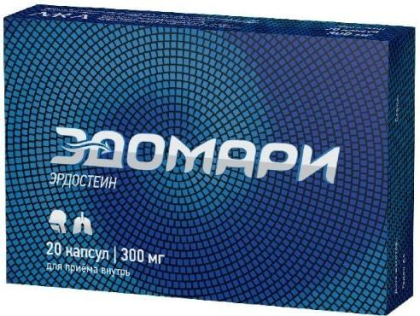Edomari (erdosteine) 300 mg
Description
Instructions for Edomari (erdosteine) 300 mg
Edomari (erdosteine) 300 mg
Description
Solid gelatin capsules with a yellow body and a green lid. Capsule content: white powder with a yellowish tint
Active substances
Erdosteine
Release Form
Capsules Edomari
Composition
Erdosteine 300 mg
Pharmacological effect Edomari
Coughing mucolytic agent
ICD-10 Code Indication
J15 Bacterial pneumonia, not elsewhere classified
J20 Acute bronchitis
J42 Chronic bronchitis, unspecified
J44 Other chronic obstructive pulmonary disease
J45 Asthma
J47 Bronchiectasis
R09.3 Sputum
pharmachologic effect Edomari
The drug’s pharmacokinetics are characterized by rapid absorption from the gastrointestinal tract and extensive liver metabolism. After metabolism, three active metabolites are formed, the most important being n-thiodiglycolyl-homocysteine (metabolite 1 or m1). The half-life (t1/2) is more than 5 hours, which indicates a long time spent in the body. General pharmacokinetic parameters are not affected by repeated drug administration or concurrent food ingestion.
The maximum concentration (Cmax) of the drug in plasma is 346 mcg/mL, and the time to reach the maximum concentration (Tmax) is 148 hours. The area under the concentration-time curve (AUC) is 12.09.
Approximately 645% of erdosteine binds to plasma proteins. The drug is eliminated from the body as inorganic sulfate through the kidneys and intestines.
When liver function is impaired, the maximal concentration (Cmax) and the area under the concentration-time curve (AUC) increase.
The elimination half-life (t1/2) may also be prolonged if severe liver malfunction is present.
When kidney failure occurs, metabolites of that drug may accumulate.
Indications Edomari
Acute and chronic bronchitis: characterized by bronchial inflammation, followed by the formation of viscous sputum.
Pneumonia: Infectious lung disease, which causes inflammation of the air bubbles, accompanied by the formation of thick sputum.
COPD (chronic obstructive pulmonary disease): A chronic disease primarily caused by smoking, characterized by respiratory problems, bronchial inflammation, and sputum production.
Asthma with sputum withdrawal difficulty: Asthma causes intermittent bronchial narrowing, which requires more effort to drain the sputum.
Bronchiectasis: A rare chronic disorder in which bronchial dilations form and may cause thick sputum to accumulate.
Prevention of pneumonia and pulmonary atelectasis after surgery: it is important to prevent the development of pneumonia and sputum accumulation after chest or bronchial surgery.
Method of application and dose Edomari
If used irrationally in antitussive therapy, consultation with a physician is recommended to avoid accumulation of fluid secretions in the bronchi and to reduce the risk of superinfection or bronchospasm.
If renal insufficiency is present, metabolites of the drug may accumulate. It is recommended to consult a doctor for the correct dosing and control.
If the liver is severely impaired, the drug’s half-life can be prolonged. You should see a doctor for the correct dosage and control.
Features
- Dosage mg 300
- Expiration Date Always fresh
- Pharmacological group Cough remedies
- Active substance erdosteine
- Weight 90 g
Categories: Cough remedies
Edomari (erdosteine) 300 mg reviews (0)
Write a reviewBe the first to write a review of this product!
